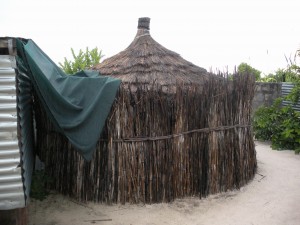I do not even know where to start, so these past 2 1/2 weeks will be split into 3 posts.
I am now back in Windhoek after 12 days in the Northern regions of the country and another 5 days in the South on the Orange River. Some of us drove the length of Namibia in two days and it was all worth it. This first post is all about the first week or so in the North where we did a rural homestay and traveled around to different schools and speakers.
Some highlights: Ruacana Falls. Cattle in the road. Juiced marula fruits. Donkeys in the road. Ate a caterpillar. Goats in the road. Woke to the sound of roosters. Slept under mosquito nets. Wore more bug spray than ever. Sat through an 8 hour bishop installation service. Saw President Pohamba in person. Stepped foot in Angola. Learned how to pound and cook mahangu. Witnessed multiple beautiful sunsets and sunrises. And saw SO MANY amazing animals!
My homestay was a good experience; my family was warm and welcoming and I stayed in a home that was an
interesting mix between traditional and modern. It was actually the biggest house I have stayed in yet, but their homestead also included traditional huts and buildings for cooking and storage. My parents and one of my sisters spoke english pretty well, but another woman in the house knew little more than “good morning.” However, I felt very accomplished when we were able to communicate while working together even if we didn’t understand the language. I
was really excited to help them juice the marula fruits which are only ripe and ready at this time of year and I was even more excited when I got to drink the juice we made! I was also taught how to pound a very popular grain called mahangu which is a staple in the diet of the Ovambo people. Pounding it is a workout and I only did it for a few minutes! Afterwards, they usually make it into a porridge using boiling water and some flour and it is served with almost every meal.
Yes, I did say I ate a caterpillar. They are popular here and it wasn’t just a little thing, it was a fat juicy green one. They cook and season them, but I still couldn’t quite handle it. One bite was enough for me, I gave the rest back to my host mother! At least I can say I tried it…
Everyday really was an adventure. Aside from the streets of Windhoek and the main roads through the country, the majority of other roads are informal and unpaved. This meant that getting to our homes in the rainy season required maneuvering through fields and puddles and hitting some major bumps. We liked to cheer on our CGE drivers every time they made it through a difficult spot; and of course my homestay family was equally skilled in driving through the dirt and mud. The livestock in the North kind of graze freely and that often meant that they decided to stand in the middle of the road, creating yet another obstacle for drivers. We all found it pretty humorous though.
Our time in the North was definitely a different experience for all of us. We all learned some lessons in traditional Namibian life like the importance of extended family and how to deal with gender roles. In my home, there were about 6 people under the age of 20 but none of them were my immediate brothers and sisters; they were all what we consider extended family. They are treated just the same though. It was also clear in my house that women fulfilled a very traditional role when it came to cooking and housework and that this was just the norm for them. It was not difficult to take part in, but it was definitely a change from what most of us are used to at home.
I could go on, but as usual, I could go on forever. So if you have more questions about what we saw or did then feel free to ask! Next up is Etosha National Park…


